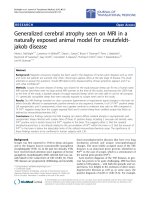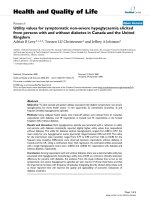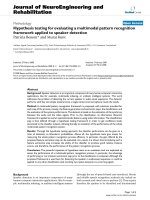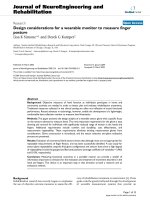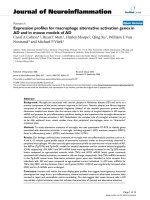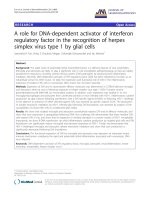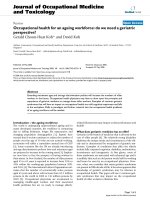Báo cáo hóa học: " Biocompatible Nanocomplexes for Molecular Targeted MRI Contrast Agent" potx
Bạn đang xem bản rút gọn của tài liệu. Xem và tải ngay bản đầy đủ của tài liệu tại đây (515.01 KB, 9 trang )
NANO EXPRESS
Biocompatible Nanocomplexes for Molecular Targeted MRI
Contrast Agent
Zhijin Chen Æ Dexin Yu Æ Shaojie Wang Æ Na Zhang Æ
Chunhong Ma Æ Zaijun Lu
Received: 16 December 2008 / Accepted: 5 March 2009 / Published online: 18 March 2009
Ó to the authors 2009
Abstract Accurate diagnosis in early stage is vital for the
treatment of Hepatocellular carcinoma. The aim of this study
was to investigate the potential of poly lactic acid–polyeth-
ylene glycol/gadolinium–diethylenetriamine-pentaacetic acid
(PLA–PEG/Gd–DTPA) nanocomplexes using as biocom-
patible molecular magnetic resonance imaging (MRI) con-
trast agent. The PLA–PEG/Gd–DTPA nanocomplexes were
obtained using self-assembly nanotechnology by incubation
of PLA–PEG nanoparticles and the commercial contrast
agent, Gd–DTPA. The physicochemical properties of
nanocomplexes were measured by atomic force microscopy
and photon correlation spectroscopy. The T
1
-weighted MR
images of the nanocomplexes were obtained in a 3.0 T
clinical MR imager. The stability study was carried out in
human plasma and the distribution in vivo was investi-
gated in rats. The mean size of the PLA–PEG/Gd–DTPA
nanocomplexes was 187.9 ± 2.30 nm, and the polydis-
persity index was 0.108, and the zeta potential was
-12.36 ± 3.58 mV. The results of MRI test confirmed that
the PLA–PEG/Gd–DTPA nanocomplexes possessed the
ability of MRI, and the direct correlation between the MRI
imaging intensities and the nano-complex concentrations
was observed (r = 0.987). The signal intensity was still
stable within 2 h after incubation of the nanocomplexes in
human plasma. The nanocomplexes gave much better image
contrast effects and longer stagnation time than that of
commercial contrast agent in rat liver. A dose of 0.04 mmol
of gadolinium per kilogram of body weight was sufficient to
increase the MRI imaging intensities in rat livers by five-fold
compared with the commercial Gd–DTPA. PLA–PEG/Gd–
DTPA nanocomplexes could be prepared easily with small
particle sizes. The nanocomplexes had high plasma stability,
better image contrast effect, and liver targeting property.
These results indicated that the PLA–PEG/Gd–DTPA
nanocomplexes might be potential as molecular targeted
imaging contrast agent.
Keywords Nanocomplexes Á Molecular imaging Á
Magnetic resonance imaging Á DTPA–Gd Á PLA–PEG
Introduction
Hepatocellular carcinoma (HCC) is one of the most dreaded
diseases in the world, which brings dramatic increases in
morbidity and mortality both in the developed and devel-
oping countries. Accurate diagnosis in early stage is vital for
the treatment of patients. Presently, routine screening strat-
egies such as ultrasound every 6 months have been
recommended for early detection in patients with liver cir-
rhosis to detect HCC at earlier stage. Magnetic resonance
imaging (MRI) is one of the most useful technologies in the
field of diagnostic imaging [1]. However, the sensitivity and
specificity of conventional MRI are far from satisfactory.
The development of molecular imaging provide an unprec-
edented opportunity for the diagnostic detection rate of HCC.
Z. Chen Á N. Zhang (&)
School of Pharmaceutical Science, Shandong University,
44 Wenhua Xi Road, 250012 Ji’nan, People’s Republic of China
e-mail:
D. Yu Á C. Ma
Department of Radiology Medicine, Affiliated Qilu Hospital,
Shandong University, 44 Wenhua Xi Road, 250012 Ji’nan,
People’s Republic of China
S. Wang Á Z. Lu (&)
School of Chemistry and Chemical Engineering, Shandong
University, 27 Shanda Road, 250012 Ji’nan, People’s Republic
of China
e-mail:
123
Nanoscale Res Lett (2009) 4:618–626
DOI 10.1007/s11671-009-9286-x
The key elements of molecular MRI are: (1) increasing the
sensitivity and specificity of the visualization procedure; (2)
improving the selectivity in tissue characterization; (3)
reducing the intrinsic image artifacts; and (4) acquiring more
functional information on the imaged processes [2]. There-
fore, the preparation of the special imaging probes with high
specificity is the key elements.
Gadolinium–diethylenetriamine pentaacetic acid (Gd–
DTPA, commercial product named as Magnevist
Ò
) is the
most commonly used MRI contrast agent that shortens the
T
1
longitudinal relaxation time of protons of water and
increases the contrast of the image because the contrast
agent shortened relaxation time. However, there are sig-
nificant problems such as short half-life in blood and lack
of specificity to target organs and tissues for diagnosis of
this low molecular weight contrast agent. Furthermore,
when Gd–DTPA was injected intravenously, they were
located in extracellular fluid and rapidly cleared from the
body. Therefore, Gd–DTPA was not suit for molecular
MRI. In order to resolve this problem, many nano-carrier
systems have been examined for the increases in relaxivity
and specificity. The carriers including proteins [3], den-
drimers [4, 5], linear polymers [6, 7], and micelles [8] have
been proposed and evaluated as molecular MRI contrast
agents. DTPA or another chelating unit was conjugated to
these carriers. None of these, however, has achieved the
increase both in relaxivity and in specificity. Therefore,
studies on molecular contrast agents special for liver with
relatively longer metabolic time and stable contrast effect
in liver tissue are still highly desired.
At present, polymer micelles combined with gadolinium
are very promising because of their ability to provide posi-
tive contrast (i.e., T
1
-weighted images), robust structural
features, and simple fabrication. In such a micelle assembly
product, the rate of water exchange is similar to that
observed in Gd–DTPA, because the Gd complex is exposed
in the exterior shell layer of the micelle [9]. The micelle that
made of macrocyclic 1,4,7,10-tetraazacyclododecane-
1,4,7,10-tetraacetic acid (DOTA) has been studied by Andre
et al.[9]. However, the DOTA was not biocompatible.
Therefore, it is necessary to study some biocompatible
contrast agent. Poly lactic acid–polyethylene glycol (PLA–
PEG) is one of the commonly used diblock copolymer with
hydrophilic and hydrophobic blocks. It allows the formation
of a stable nano-particulate suspension in an aqueous sol-
vent, where PLA chains form the core and PEG chains are
located outside [10]. The PEG shell prevents the interaction
of PLA core with biomolecules, cells, tissues, and can sup-
press opsonization [11]. The PLA–PEG micelle had been
successfully used for drug delivery by Pierri [12], but the
micelle was not suitable for the molecular contrast agent
because the micelles mostly stay within lymph fluid rather
than accumulation in the nodal macrophages and rapidly
move via the lymphatic pathway [13]. Furthermore, the
micelle structure may dissociate in the bloodstream into a
single polymer chain, and the gadolinium will be rapidly
excreted out of the body, which was not advantage to
diagnose [14]. Reportedly, PLA–PEG nanoparticles show a
particle size of several dozen to a few hundred nanometers,
and possess a hydrophilic and inactive surface of PEG,
leading to a longer systemic circulation [15]. Therefore, the
main purpose of this study is to investigate the possibility of
the core–shell PLA–PEG nanoparticles to be used as novel
target molecular MRI contrast agent nano-carriers for the
diagnostic detection of HCC.
First, the core–shell PLA–PEG nanoparticles were pre-
pared, and then the Gd–DTPA was absorbed to the surface
of the PLA–PEG nanoparticles by self-assembly nano-
technology to obtain the nanocomplexes as contrast agent
for molecular MRI. The formulation was tested for physi-
cal parameters such as particle size, zeta potential, image
contrast effect, and the stability in human plasma. The
gadolinium content of the nanocomplexes was determined
by inductively coupled plasma-atomic emission spectros-
copy. The distribution in vivo was studied in rats after
intravenous injection to confirm the targeting property.
Materials and Methods
Materials
Wistar rat were purchased from the experimental animal
center of Shandong University. All animal test procedures
were performed in accordance with the National Institutes
of Health guidelines on the use of animals in research. MRI
was conducted under anesthesia by intraperitoneal injec-
tion of pentobarbital (50 mg/kg of body weight).
PLA–PEG (MW
PLA
= 48,000 Da, MW
PEG
= 4,000 Da)
was a gift kindly provided by School of Chemistry and
Chemical Engineering of Shandong University (Jinan,
China). Gadopentetic acid dimeglumine salt injection
(Gd–DTPA, Magnevist
Ò
) was purchased from Bayer
Schering Pharma AG. All other chemicals were of ana-
lytical reagent or higher grade.
Preparation of the Nanocomplexes
Preparation of PLA–PEG Blank Nanoparticles
The PLA–PEG blank nanoparticles were produced by
modified solvent diffusion method [16]. Briefly, 1.5 mL
organic polymer solution (40 mg of PLA–PEG dissolved
in methylene chloride) was dropped into 25 mL EtOH at
8 mL/h (KdScientific U.S.A) under moderate stirring, lead-
ing to the immediate polymer precipitation. Subsequently, in
Nanoscale Res Lett (2009) 4:618–626 619
123
order to facilitate the collection of the particles, 25 mL of
Milli-Q water was added to the nanoparticles suspension,
and the stirring was maintained for 10 min. Finally, the
organic solvents were eliminated by evaporation under
vacuum at 37 °C and the blank nanoparticles were collected.
Preparation of PLA–PEG/Gd–DTPA Nanocomplexes
The nanocomplexes were produced by self-assemble
nanotechnology. Briefly, 1.0 mL of Gd–DTPA solution
(0.5 mmol/mL) was added dropwise to 7 mL of PLA–PEG
blank nanoparticles suspension under gentle vortexing for
20 s. Subsequently, the sample was incubated at room
temperature for 30 min to facilitate complexation. The
nanocomplexes were obtained by centrifuging at 15,000
rpm for 30 min at 4 °C (Shanghai Anting Scientific Instru-
ment Co., Ltd, China), washed thrice by Milli-Q water,
subsequently resuspended in Milli-Q water, and filtered
through a membrane with 0.80 lm pore size (Phenomenex,
25 mm filter, CA, USA). The gadolinium content of the
nanocomplexes was determined by inductively coupled
plasma-atomic emission spectroscopy.
Investigation the Physico-Chemical Properties
of the Nanoparticles and the Nanocomplexes
Transmission Electron Microscopy (TEM) and Photon
Correlation Spectroscopy (PCS) Analysis
The size and morphology of nanoparticles were examined
using a transmission electron microscope (JEM-1200EX,
Jeol, Japan). A carbon-coated 200-mesh copper specimen
grid was glow-discharged for 1.5 min. One drop of nano-
particle suspension was deposited on the grid and allowed to
stand for 1.5 min after which any excess fluid was removed
with filter paper. The grid was later stained with one drop of
2% aqueous solution of sodium phosphotungstate for contrast
enhancement. The grids were allowed to dry for an additional
10 min before examination under the electron microscope.
Size and zeta potential of the nanocomplexes were
analyzed in triplicates by photon correlation spectroscopy
and laser Doppler anemometry, respectively, using a par-
ticle sizer (Zetasizer 3000 HAS, Malvern Instruments Ltd.,
Malvern, Worcestershire, UK). Samples were analyzed
after appropriate dilution in MilliQ water. Reported values
were expressed as mean ± standard deviation for at least
three different batches of each nanocomplexes formulation.
Atomic Force Microscopy Imaging (AFM)
Atomic force microscopy observation was performed in air
at room temperature, on a Dimension 3000 apparatus, as
well as on Multimode Equipment, both monitored by a
Nanoscope IIIa controller from Digital Instruments (Santa
Barbara, CA, USA). A droplet (5 lL) of sample was
deposited on a freshly cleaved silicon surface, spread and
partially dried with a stream of argon. The images were
obtained in tapping mode (Tapping mode atomic force
microscopy, TM-AFM), using commercial silicon probes,
from Nanosensors
TM
, with cantilevers having a length of
228 lm, resonance frequencies of 75–98 kHz, spring
constants of 29–61 N/m, and a nominal tip curvature radius
of 5–10 nm. The scan rate was 1 Hz. Dimensional analyses
were performed using the ‘‘section of analyses’’ program of
the system. A minimum of 10 images from each sample
was analyzed to assure reproducible results.
Magnetic Resonance Imaging In Vitro
In vitro MRI test was performed with a 3.0 T magnet at
Philips Achieva 3.0T MRI (Philips Co., Netherlands). The
T
1
-weighted MR images of the prepared nanocomplexes and
a commercially available contrast agent, Gd-DTPA, were
obtained. MR images were taken with different concentra-
tions of Gd solution (1 9 10
-4
to 1 9 10
-3
mM Gd/L). The
blank PLA–PEG nanoparticles were taken as the control.
The experimental condition was as follows: TR (repetition
time) = 5.2 ms, TE (echo delay time) = 2.1 ms, flip angle:
4.0, field of view: 26 9 20 cm
2
.
Stability of the Nanocomplexes in Human Plasma
The stability of the nanocomplexes was determined in the
presence of 50% human plasma at 37 °C. Two-hundred
microliters of nanocomplexes were incubated with 200 lL
of human plasma at 37 °C for 0, 0.5, 1.0, and 2.0 h,
respectively. To isolate nanocomplexes from human
plasma, the mixture was separated by centrifugation at
15,000 rpm for 30 min at 4 °C, washed thrice, and subse-
quently resuspended in Milli-Q water. The each
resuspension was determined by MRI. The particle size
was determined by TEM after incubation in plasma and
compared with the freshly prepared sample.
Evaluation of In Vivo Distribution
Twelve Wistar rats were examined to evaluate the in vivo
distribution of the nanocomplexes. Animals were divided
into two groups, receiving either Gd–DTPA (n = 6) or
PLA–PEG/Gd–DTPA nanocomplexes (n = 6). The rats
were imaged on a 3-Tesla clinical scanner (Philips Co.,
Netherlands) using a knee coil array comprised two mod-
ified Alderman-Grant resonators. A tail vein cannula
consisting of a 30-gauge needle attached to Tygon tubing
(2.0 m length) was then established. The two image agents
were injected via the tail vein catheter with an infusion
620 Nanoscale Res Lett (2009) 4:618–626
123
pump (6 mL/min). A 0.04 mmol/kg body weight aliquot of
the contrast agent solution was injected. The targeting
efficiency (TE
C
) of nanocomplexes were calculated and
compared with Gd–DTPA to evaluate the tissue targeting
property after intravenous administration. Targeting effi-
ciency (TE
C
) was calculated from Eq. 1. The mean area
under the curve (AUC) of PLA–PEG nanocomplexes
concentrations in organs was calculated by the trapezoidal
method during the experimental period (AUC
[0–8]
)
TE
C
¼
AUC
nanocomplexes
AUC
GdÀDTPA
: ð1Þ
Results
Characterization of the Nanocomplexes
The morphology of PLA–PEG blank nanoparticles and the
PLA–PEG/Gd–DTPA nanocomplexes was investigated
using transmission electron microscopy. The nanoparticles
and the nanocomplexes had spherical or ellipsoidal shapes
(Fig. 1). Results of size and zeta potential measurements
by PCS are shown in Table 1 and Fig. 2. The size of the
nanopcomplexes was smaller than 200 nm. The result of
AFM showed that the blank nanoparticles were 56 nm. The
nanocomplexes were 70 nm, which was larger than the
blank nanoparticles in dried state (Figs. 3, 4). The size of
PLA–PEG and nanocomplexes was 56 and 70 nm,
respectively, in the AFM image, which was different from
that observed by PCS. It might be explained that the AFM
image was taken at the drying condition and the PCS was
taken at the suspension. The PEG chain of the nanocom-
plexes was extended in the suspension and folded at the
drying state.
Magnetic Resonance Imaging
In order to assess the effect of increasing amounts of
Gd–DTPA on the complexes image enhancement, the
doses of Gd–DTPA from 1 9 10
-4
to 1 9 10
-3
mmol/mL
were tested. The image intensity increases and the T
l
relaxation time shorten as a function of the amount of
contrast agent included in the complexes (Fig. 5). The
results of MRI test confirmed that the PLA–PEG/Gd–
DTPA nanocomplexes possessed the ability of MRI, and
the direct correlation between the MRI intensities and the
nanocomplexes concentrations was observed (r = 0.987).
The blank PLA–PEG nanoparticles did not enhance the
signal intensity, which confirmed the Gd–DTPA was
absorbed to the surface of the nanoparticles.
Stability of the Nanocomplexes in Human Plasma
The results of the stability experiment showed that the
nanocomplexes’ morphology did not change after incuba-
tion for 2 h as observed under TEM (data not shown). The
MRI signal intensity of the nanocomplexes decreased after
incubation with the plasma for 2 h, but no noticeable dif-
ference was detected (P [ 0.05). The result of the
experiment indicated that the nanocomplexes were stable
in human plasma for at least 2 h (Fig. 6).
Magnetic Resonance Imaging In Vivo
Images of the in vivo experiment with Gd–DTPA in rat
were displayed in Fig. 7. In the preinjection image, the
vena cava, the kidneys, and the liver were dark owing to
the choice of the inversion delay (Fig. 7a, e).
After injection of Gd–DTPA (30 s), the urinary bladder
became extraordinary lighter (236.54 ± 24.72 to 960.6 ±
27.56) owing to the introduction of the contrast agent. The
kidney was bright also and the signal intensity was
increased from 278 ± 13.64 to 923 ± 19.02 (Fig. 7b),
Fig. 1 TEM results of the blank nanoparticles and the nanocomplexes
Table 1 Result of physicochemical properties of the nanoparticles
and the nanocomplexes
Size (nm) Polydispersity
index
Zeta potential
(mV)
Blank nanoparticles 146.87 ± 3.10 0.107 -15.72 ± 4.88
Nanocomplexes 187.9 ± 2.30 0.108 -12.36 ± 3.58
Nanoscale Res Lett (2009) 4:618–626 621
123
followed by a rapid decay in signal intensity. As shown in
Fig. 7c, the signal intensity of the liver had increased from
302 ± 16.67 to 504 ± 21.01 at 60 s after injection. The
whole body of the rat was as dark as preinjection 1 h later
following injection of Gd–DTPA (Fig. 7d).
The signal intensity in the liver gradually increased after
injection of the nanocomplexes compared with the
Gd–DTPA (shown Fig. 7f, g). One hour later, the signal
intensity of the liver reached the highest (from
309 ± 14.21 to 482 ± 11.91), and then attenuated slowly
(Fig. 7g). The enhanced signal intensities of the liver
continue 4 h after injection of the nanocomplexes, while
continued 10 min only after injection Gd–DTPA. The
contrast intensity–time curves of the rat liver after injection
of Gd–DTPA and PLA–PEG/Gd–DTPA nanocomplexes
were shown in Fig. 8. The slow rising of intensity curve of
nanocomplexes might be attributed to the gadolinium
released slowly from the complexes. The AUC (area under
contrast intensity–time curves) enhancement of the nano-
complexes was 4.98-fold greater than that of Gd–DTPA.
The kidneys and urinary bladders became lighter gradually,
and reached the highest within 2 h postinjection of the
nanocomplexes (271 ± 25.32 to 703 ± 36.7 for kidneys
and 279 ± 28.51 to 1578 ± 35.08 for urinary bladders).
From the scheme, the enhancement was not significantly
different in the lung between the two contrast agents at the
same time in vivo.
The in vivo distribution result of the nanocomplexes was
shown in Fig. 9. The results of the TE
C
confirmed that the
nanocomplexes were targeted to the muscle and the heart,
Fig. 2 Size distribution of the
blank nanoparticles and the
nanocomplexes
Fig. 3 AFM images of PLA–
PEG blank nanoparticles
showing spherical obtained in
tapping mode. Scan sizes are
800 nm
622 Nanoscale Res Lett (2009) 4:618–626
123
which was not macroscopic. The TE
C
of the liver was 4.98,
which indicated that the nanocomplexes can effectively
concentrate to the liver and enhance the signal intensity
(Table 2).
Discussion
The blank PLA–PEG nanoparticles prepared by modified
solvent diffusion method were homogeneous with respect to
the minor polydispersity index (\0.2) and can be considered
monodisperse. The nanocomplexes were smaller than
200 nm, which could be considered optimal for Stealth
Ò
systems to prevent the filtering in the spleen and increase the
uptake by macrophages [17]. It is evident from the results of
PCS experiments that the hydrodynamic diameter of the
nanoparticles in the solvated state is larger than that obtained
from TEM experiments [18]. Some authors have demon-
strated that the mean diameter of nanoparticles has an
influence on the biodistribution studies. The particles within
the 150–200 nm range were found to be longest circulating
[19, 20], and so the PLA–PEG/Gd–DTPA nanocomplexes,
with sizes around 200 nm, could be particularly interesting
to reach the loose junctions of the endothelium of cancer or
infectious foci, considering the mean sizes measured by
PCS. Nanoparticle with mean diameters of 190 nm was
selected for use because the nanoparticle accessing to
hepatocytes through the hepatic sinusoidal wall requires the
passage through endothelial cell pores that are estimated at
150–200 nm [21]. Zeta potential results (Table 1) showed
Fig. 4 AFM images of PLA–
PEG/Gd–DTPA nanocomplexes
showing spherical obtained in
tapping mode. Scan sizes are
3 lm
Fig. 5 Imaging intensity of
nanocomplexes dependent on
the dose of Gd–DTPA
Fig. 6 Stability of the
nanocomplexes in human
plasma
Nanoscale Res Lett (2009) 4:618–626 623
123
that the blank PLA–PEG nanoparticles and PLA–PEG/Gd–
DTPA nanocomplexes exhibited a negative charge with
values ranging from -12.36 to -15.72 mV. The nanopar-
ticles have moderately anionic surface potentials (at the
plane of hydrodynamic shear) to minimize nonspecific
uptake. Cationic particles are internalized nonspecifically
through proteoglycan receptors and may stick to anionic cell
surface membranes, while highly anionic polystyrene
nanoparticles have increased nonspecific uptake by scav-
enger receptors following complement activation [22, 23].
The Gd–DTPA loaded PLA–PEG nanoparticles belong
to self-assembly nanotechnology. Therefore, the self-
assembly nanotechnology between like-charge has been
study for years [24, 25]. Messina et al. [26] have investi-
gated the complexation of highly charged sphere with long
flexible polyelectrolyte, both negatively charged in a salt-
free environment. They observed multilayer of the highly
charged polyelectrolyte chains confined to the sphere for
lower charge density, the polyelectrolyte chain wrapped
around the sphere. A mechanism involving Coulomb cou-
pling was proposed to explain the structures. In our design,
the PLA–PEG nanoparticle would be seen as the charged
sphere and the Gd–DTPA was seen as the polyelectrolyte,
and the nanocomplexes formulation could be explained by
the Coulomb coupling theory. Piroll et al. [27] also have
prepared liposome complexes with Gd–DTPA by the same
mechanism.
Contrast of the nanocomplexes was substantially
improved and remained unchanged for at least 2 h after
incubation with the human plasma. This stability in human
plasma was contributed to the PEG chain of the
Fig. 7 Imaging of Gd–DTPA and PLA–PEG/Gd–DTPA nanocomplexes in vivo
Fig. 8 The contrast enhanced intensity-time curves of rat liver after
injection of Gd–DTPA and nanocomplexes
624 Nanoscale Res Lett (2009) 4:618–626
123
nanocomplexes. Folding of the PEGs leads to the formation
of PEG coils including Gd–DTPA molecules, which are
compactly bound to the ether groups of the PEG chains, and
the water molecules were loosely bound to the PEG chains
[28]. Therefore, a heavily hydrated coating layer consisting
of conformational random PEG chains covers the underly-
ing surface [29, 30]. Therefore, the surface is protected
against adsorbing proteins because of the unfavorable
entropy change that results in compression of this coating
layer [30]. In addition, the negative charges of the nano-
complexes could prevent the nanocomplexes from plasma
protein binding. If serum proteins bind to the surface of
nanocomplexess, the cross-linking between nanocomplexes
would be expected to occur. However, this phenomenon was
not observed from TEM after incubation.
The signal intensity of the nanocomplexes was depen-
dent on the Gd–DTPA concentration, which was absorbed
onto the surface of the nanocomplexes. The correlation
coefficient of the signal intensity and the concentration of
the Gd–DTPA nanocomplexes was 0.987. Thus, the
concentration of the nanocomplexes could be determined
by the signal intensity in vivo at different times. The results
of the imaging experiment in vitro showed that the blank
PLA–PEG nanoparticles did not enhance the signal inten-
sity, which confirmed the Gd–DTPA was absorbed onto the
surface of the nanoparticles.
A dose of 0.04 mmol of gadolinium per kilogram of
body weight was sufficient to increase the liver signal by
4.98-fold after injection of the nanocomplexes compared
with Gd-DTPA. Contrast was substantially improved and
remained for 4 h after administration. In contrast, the Gd–
DTPA solution just remained for 10 min.
Comparing the intensity results in Figs. 8 and 9, the
highest signal intensity was not increased by the nano-
complex. In addition, the highest intensity in liver was
similar with the Gd–DTPA injection. The nanocomplexes
enhanced the retention time of Gd–DTPA in vivo and
increased the live distribution due to the passive target
mechanism. Furthermore, the contrast of the nanocom-
plexes lasted for 4 h that is longer than the free Gd–DTPA,
which is the advantage of diagnosing in the clinical. The
delayed signal of the nanocomplexes was benefit for
diagnosing in the clinical. The signal intensity of free Gd–
DTPA decreased too quickly to obtain accurate images and
so it was difficult to observe the different organs or dif-
ferent parts of organs after a single injection. It is possible
to observe and compare different organs or different parts
of the organs carefully due to the enhanced retention time
of the nanocomplexes. More accurate diagnosis and more
precise conclusion would be obtained due to the delayed
signal intensity. The kidneys were become brightly after
2 h administration of the nanocomplexes seems to be
Fig. 9 Distribution in vivo of the Gd–DTPA and nanocomplexes in rats after intravenous injection
Table 2 Result of the AUC of the enhanced intensity of the Gd–
DTPA and the nanocomplexes (n = 6)
AUC
(0–8 h)
TE
C
Gd–DTPA Nanocomplexes
Liver 99.11 ± 14.68 493.78 ± 16.67 4.98
Lung 1.29 ± 0.35 1.13 ± 0.41 0.88
Heart 43.80 ± 8.56 84.46 ± 12.31 1.92
Muscle 13.21 ± 7.32 191.69 ± 15.60 14.51
Kidney 232.18 ± 29.32 1218.15 ± 67.69 16.95
Nanoscale Res Lett (2009) 4:618–626 625
123
related to the delayed blood clearance compared with Gd–
DTPA. On the other hand, this result could suggest that the
nanocomplexes have a renal elimination [31]. Of course,
such a route of excretion can only be confirmed by urine
measurement of the Gd concentration, but this nanocom-
plexes size that allow their retention in kidney are known to
be freely excreted through the fenestrated capillaries of the
kidney [32].
Conclusion
The PLA–PEG blank nanoparticles were prepared by
modified solvent diffusion method. Then, the Gd–DTPA
was absorbed onto the surface of the nanoparticles to
obtain the nano complexes by self-assembly nanotechnol-
ogy. The nanocomplexes were stable in human plasma at
least for 2 h. The results of the biodistribution experiments
confirmed that the nanocomplexes had long stagnation time
in the liver and could target to the liver. In summary, we
have successfully demonstrated the feasibility of the
experimental biodegradable (Gd–DTPA) nanocomplex
contrast agent to perform effective MRI in rats.
Acknowledgments The research was supported by the national
science foundation for post-doctoral scientists of China
(20070421081) and the specialized fund for the post-doctoral creative
program of Shan dong province of China (200703065).
References
1. G. de Marco, A. Bogdanov, E. Marecos, A. Moore, M. Simonova,
R. Weissleder, Radiology 208(1), 65 (1998)
2. R. Weissleder, Radiology 212(3), 609 (1999)
3. T.N. Nagaraja, K. Karki, J.R. Ewing, R.L. Croxen, R.A. Knight,
Stroke 39, 427 (2008). doi:10.1161/strokeaha.107.496059
4. H. Xu, C.A.S. Regino, Y. Koyama, Y. Hama, A.J. Gunn,
M. Bernardo, H. Kobayashi, P.L. Choyke, M.W. Brechbiel,
Bioconjug. Chem. 18, 1474 (2007). doi:10.1021/bc0701085
5. H. Xu, C.A.S. Regino, M. Bernardo, Y. Koyama, H. Kobayashi,
P.L. Choyke, M.W. Brechbiel, J. Med. Chem. 50(14), 3185
(2007). doi:10.1021/jm061324m
6. X.X. Wen, E.F. Jackson, R.E. Price, E.E. Kim, Q.P. Wu,
S. Wallace, C. Charnsangavej, J.G. Gelovani, C. Li, Bioconjug.
Chem. 15(6), 1408 (2004). doi:10.1021/Bc049910m
7. E. Toth, L. Helm, K.E. Kellar, A.E. Merbach, Chem. Eur. J. 5(4),
1202 (1999). doi:10.1002/(SICI)1521-3765(19990401)5:4\1202::
AID-CHEM1202[3.0.CO;2-Y
8. W.J.M. Mulder, G.J. Strijkers, K.C. Briley-Saboe, J.C. Frias,
J.G.S. Aguinaldo, E. Vucic, V. Amirbekian, C. Tang, P.T.K.
Chin, K. Nicolay, Z.A. Fayad, Magn. Reson. Med. 58, 1164
(2007). doi:10.1002/mrm.21315
9. J.P. Andre, E. Toth, H. Fischer, A. Seelig, H.R. Macke, A.E.
Merbach, Chem. Eur. J. 5(10), 2977 (1999). doi:10.1002/(SICI)
1521-3765(19991001)5:10\2977::AID-CHEM2977[3.0.CO;2-T
10. D. Bazile, C. Prudhomme, M.T. Bassoullet, M. Marlard,
G. Spenlehauer, M. Veillard, J. Pharm. Sci. 84(4), 493 (1995).
doi:10.1002/jps.2600840420
11. C.A. Nguyen, E. Allemann, G. Schwach, E. Doelker, R. Gurny,
J. Pharm. Sci. 254(1), 69 (2003). doi:10.1016/S0378-5173(02)
00685-3
12. S.S. Venkatraman, P. Jie, F. Min, B.Y. Freddy, G. Leong-Huat,
Int. J. Pharm. 298(1), 219 (2005)
13. V.P. Torchilin, J. Control. Release 73(2–3), 137 (2001). doi:
S0168365901002991
14. E. Nakamuraa, K. Makinoa, T. Okanob, T. Yamamotoc,
M. Yokoyama, J. Control. Release 114(3), 325 (2006)
15. R. Gref, P. Quellec, A. Sanchez, P. Calvo, E. Dellacherie,
M.J. Alonso, Eur. J. Pharm. Biopharm. 51(2), 111 (2001). doi:
10.1016/S0939-6411(00)00143-0
16. C. Perez, A. Sanchez, D. Putnam, D. Ting, R. Langer, M.J.
Alonso, J. Control. Release 75(1-2), 211 (2001). doi:10.1016/
S0168-3659(01)00397-2
17. C.D. Oja, S.C. Semple, A. Chonn, P.R. Cullis, Biochim. Biophys.
Acta 1281(1), 31 (1996). doi:10.1016/0005-2736(96)00003-X
18. T. Riley, S. Stolnik, C.R. Heald, C.D. Xiong, M.C. Garnett,
L. Illum, S.S. Davis, S.C. Purkiss, R.J. Barlow, P.R. Gellert,
Langmuir 17(11), 3168 (2001). doi:10.1021/la001226i
19. D.C. Litzinger, A.M.J. Buiting, N. Vanrooijen, L. Huang, Bio-
chim. Biophys. Acta 1190(1), 99 (1994). doi:0005-2736(94)900
38-8
20. D.E. Owens, N.A. Peppas, Int. J. Pharm. 307(1), 93 (2006). doi:
10.1016/j.ijpharm.2005.10.010
21. E. Wisse, R.B. De Zanger, K. Charels, P. Van Der Smissen,
R.S. McCuskey, Hepatology 5(4), 683 (1985). doi:10.1002/hep.
1840050427
22. R. Gref, G. Miralles, E. Dellacherie, Polym. Int. 48, 251 (1999).
doi:10.1002/(SICI)1097-0126(199904)48:4\251::AID-PI104[
3.0.CO;2-4
23. K. Ogawara, M. Yoshida, K. Higaki, T. Kimura, K. Shiraishi,
M. Nishikawa, Y. Takakura, M. Hashida, J. Control. Release 59,
15 (1999). doi:S0168365999000152
24. J.A. Libera, H. Cheng, M.O. Cruz, M.J. Bedzyk, J. Phys. Chem.
B 109(48), 23001 (2005). doi:10.1021/jp0534941
25. F. Molnar, J. Rieger, Langmuir 21(2), 786 (2005). doi:10.1021/
la048057c
26. R. Messina, C. Holm, K. Kremer, J. Chem. Phys. 117(6), 2947
(2002). doi:10.1063/1.1490595
27. K.F. Pirollo, J. Dagata, P. Wang, M. Freedman, A. Vladar, S.
Fricke, L. Ileva, Q. Zhou, E.H. Chang, Mol. Imaging 5(1), 41
(2006). doi:10.2310/7290.2006.00005
28. R. Gref, M. Luck, P. Quellec, M. Marchand, E. Dellacherie, S.
Harnisch, T. Blunk, R.H. Muller, Colloids Surf. B Biointerfaces
18(3–4), 301 (2000). doi:S0927-7765(99)00156-3
29. W.R. Gombotz, W. Guanghui, T.A. Horbett, A.S. Hoffman,
J. Biomed. Mater. Res. A 25(12), 1547 (1991). doi:10.1002/jbm.
820251211
30. K. Bergstrom, E. Osterberg, K. Holmberg, A.S. Hoffman, T.P.
Schuman, A. Kozlowski, J.H. Harris, J. Biomater. Sci. Polym. Ed.
6(2), 123 (1994). doi:10.1163/156856294X00257
31. G. Yu, M. Yamashita, K. Aoshima, M. Takahashi, T. Oshikawa,
H. Takayanagi, S. Laurent, C. Burtea, L. Vander, L. Vander Elst,
R.N. Muller, Bioorg. Med. Chem. Lett. 17(8), 2246 (2007). doi:
S0960-894X(07)00117-5
32. Y. Okuhata, Adv. Drug Deliv. Rev. 37(1-3), 121 (1999). doi:
S0169-409X(98)00103-3
626 Nanoscale Res Lett (2009) 4:618–626
123

